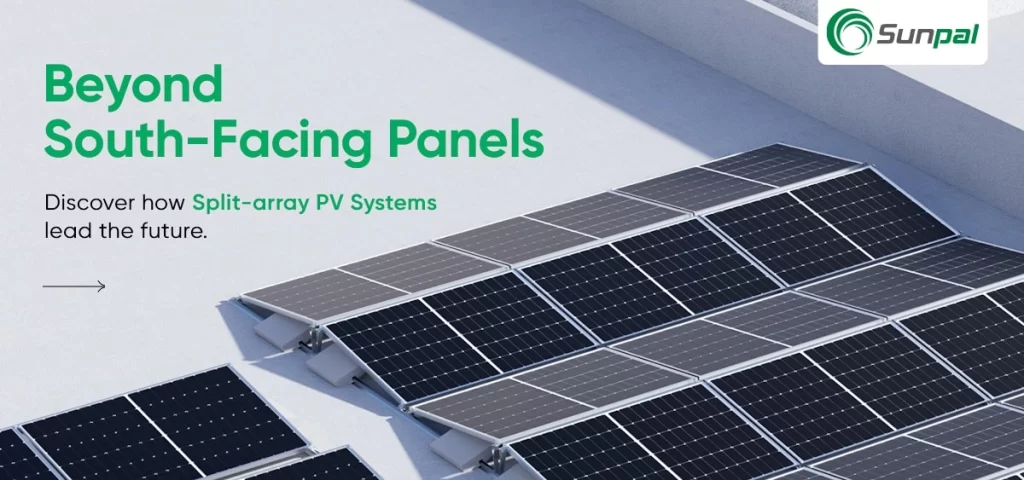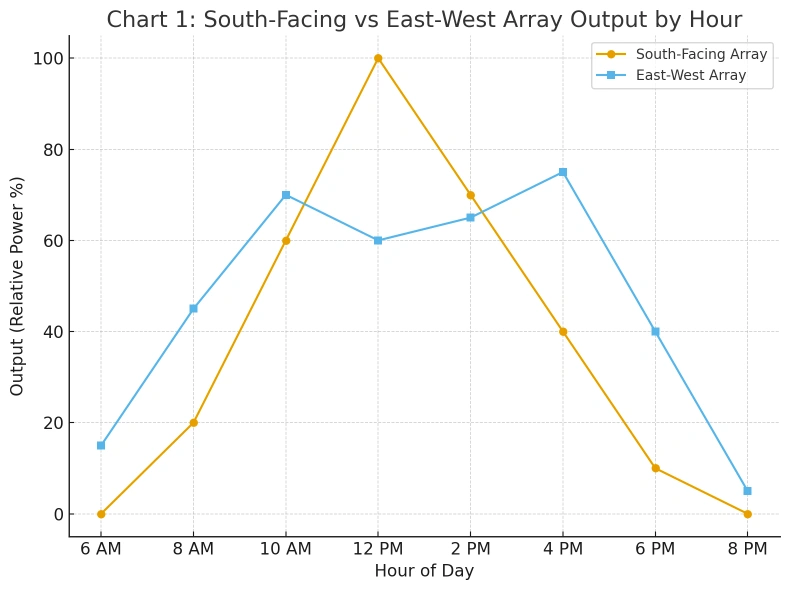
As global solar adoption accelerates, east-west PV systems are redefining performance metrics, offering higher self-consumption, better grid integration, and smarter economics than traditional south-facing designs.
Rethinking Solar Orientation in a Changing Energy Landscape
For decades, the formula for solar installations seemed straightforward: orient modules toward the south (in the northern hemisphere) or north (in the southern hemisphere) to capture maximum sunlight. This practice optimized total annual generation, particularly in residential projects where maximizing yield was once the top priority.
But the energy landscape has evolved. Electricity consumption patterns, grid constraints, and policy incentives are reshaping the economics of solar. A midday production peak—once considered ideal—can now overload local networks, create curtailment challenges, and reduce profitability.
Enter the east-west solar PV system, also known as the split-array configuration. By dividing panels across two orientations—east-facing for morning generation and west-facing for afternoon generation—these systems flatten the output curve, aligning energy supply with actual demand. This makes them particularly appealing for commercial, industrial, and high-density urban projects where energy efficiency and self-consumption rates are critical.
From South to East-West: A Shift in Design Philosophy
Historically, solar economics rewarded total kilowatt-hour production above all else. That is why south-facing arrays dominated rooftops, farms, and even large utility-scale projects. While effective in maximizing sunlight exposure, the approach concentrated energy generation around midday—precisely when demand is often lowest and wholesale electricity prices drop.
This mismatch between supply and demand pushed the industry to rethink orientation strategies. East-west arrays emerged as a practical alternative, especially in Europe, where dense urban environments and limited rooftop space required optimized layouts. By favoring load matching over absolute yield, split-array systems represent a more sophisticated and grid-conscious design philosophy.
Why East-West Systems Outperform South-Facing Designs
Flatter Energy Production Curve
Unlike south-facing systems, which produce a sharp peak around noon, east-west arrays deliver a steadier curve that stretches from morning through evening. This reduces reliance on the grid during peak demand hours.
Chart 1: Daily Output Comparison (Relative Power %)

South-facing peaks at noon, while east-west delivers steadier power across the day.
Higher Self-Consumption Rates
In markets where القياس الصافي is limited or where feed-in tariffs have been phased out, self-consumption has become the new driver of solar economics. By better matching on-site demand, east-west arrays often achieve 15–25% higher self-consumption, allowing businesses to cut electricity bills and reduce exposure to volatile grid prices.
Better Roof Utilization
South-facing systems on flat rooftops require spacing between rows to avoid shading, limiting capacity. East-west arrays, on the other hand, use back-to-back racking, enabling up to 20–30% greater installed capacity on the same surface area. For logistics warehouses, industrial facilities, and shopping centers, this translates into significantly higher energy independence.
Cost and Grid Benefits
Balanced energy production reduces midday curtailment and avoids triggering costly grid upgrades. Additionally, balance-of-system costs—such as cabling, inverters, and mounting hardware—are optimized in east-west designs, further lowering the levelized cost of energy (LCOE).
Market Evidence: Adoption and Performance
Across Europe, east-west rooftop systems are rapidly gaining market share. Countries such as Germany and the Netherlands, where flat commercial rooftops dominate, have seen split-array adoption grow steadily over the past decade.
Chart 2: Rooftop PV Capacity Growth in Europe (2015–2024, GW)

East-west rooftop installations surpassed south-facing designs after 2021, reflecting changing adoption trends.
Performance evaluations highlight a clear trade-off: south-facing systems may produce 3–5% more energy annually, but east-west designs deliver superior financial returns thanks to higher self-consumption and improved load matching.
Real-World Applications
- Industrial Facilities: Factories with continuous daytime operations benefit from a smoother power profile.
- Urban Rooftops: East-west racking minimizes shading and maximizes roof coverage, ideal for city installations.
- Commercial Parks: Multiple tenants with staggered energy demand can share balanced generation patterns.
- Utility-Scale Projects: In regions with grid congestion, east-west layouts help avoid midday bottlenecks.
Chart 3: Cost per kWh Comparison (LCOE, $/kWh)

East-west systems show a lower cost per kWh when factoring in higher self-consumption and reduced curtailment.
Challenges and Considerations
Despite the clear advantages, east-west arrays present some challenges:
- Lower Annual Yield: Depending on latitude, total energy output may be slightly less than south-facing designs.
- Structural Requirements: Flat rooftops require robust racking systems that can withstand wind and snow loads.
- Design Expertise: Proper string sizing, inverter matching, and shading analysis are crucial for maximizing performance.
Yet these issues are manageable, particularly as advances in bifacial solar panels and tracking systems further improve east-west economics.
The Bigger Picture: Aligning with Energy Transition Goals
The global energy transition demands not just more renewable capacity but also smarter deployment. East-west PV systems play a unique role in addressing three critical challenges:
- استقرار الشبكة: Flatter output reduces the risk of overloading distribution networks.
- Decentralization: Rooftop east-west arrays empower businesses and communities to generate more of their own power.
- كفاءة التكلفة: Lower LCOE makes solar more competitive against fossil fuels without relying on subsidies.
Policymakers are also recognizing these advantages. Incentives in several European markets now reward self-consumption and peak shaving rather than raw generation, aligning perfectly with east-west system characteristics.
Looking Ahead: The Role of East-West PV in the Energy Transition
Solar energy is entering a stage where design innovation will determine the next leap in adoption. The industry's focus is shifting from panel efficiency alone to system-level optimization—integrating storage, digital controls, and smarter orientations.
East-west arrays are expected to play a vital role in:
- Commercial Solar Growth: Offering higher rooftop utilization in dense urban areas.
- Hybrid Systems: Pairing with batteries to extend usable energy into the night.
- Corporate Sustainability: Helping companies meet ambitious carbon reduction goals with predictable, reliable on-site power.
خاتمة
The assumption that south-facing solar arrays are always superior is rapidly becoming outdated. In a world where grid integration, consumption patterns, and cost efficiency matter more than raw yield, east-west PV systems stand out as the smarter choice.
بالنسبة لـ صنبال للطاقة الشمسية, this shift underscores the importance of innovative system design. By delivering solutions that combine advanced solar modules, optimized orientations, and smart inverters, we help businesses and communities unlock the full potential of renewable energy.
East-west solar is more than an engineering tweak—it is a strategic step forward in aligning solar power with the needs of tomorrow's energy systems.
